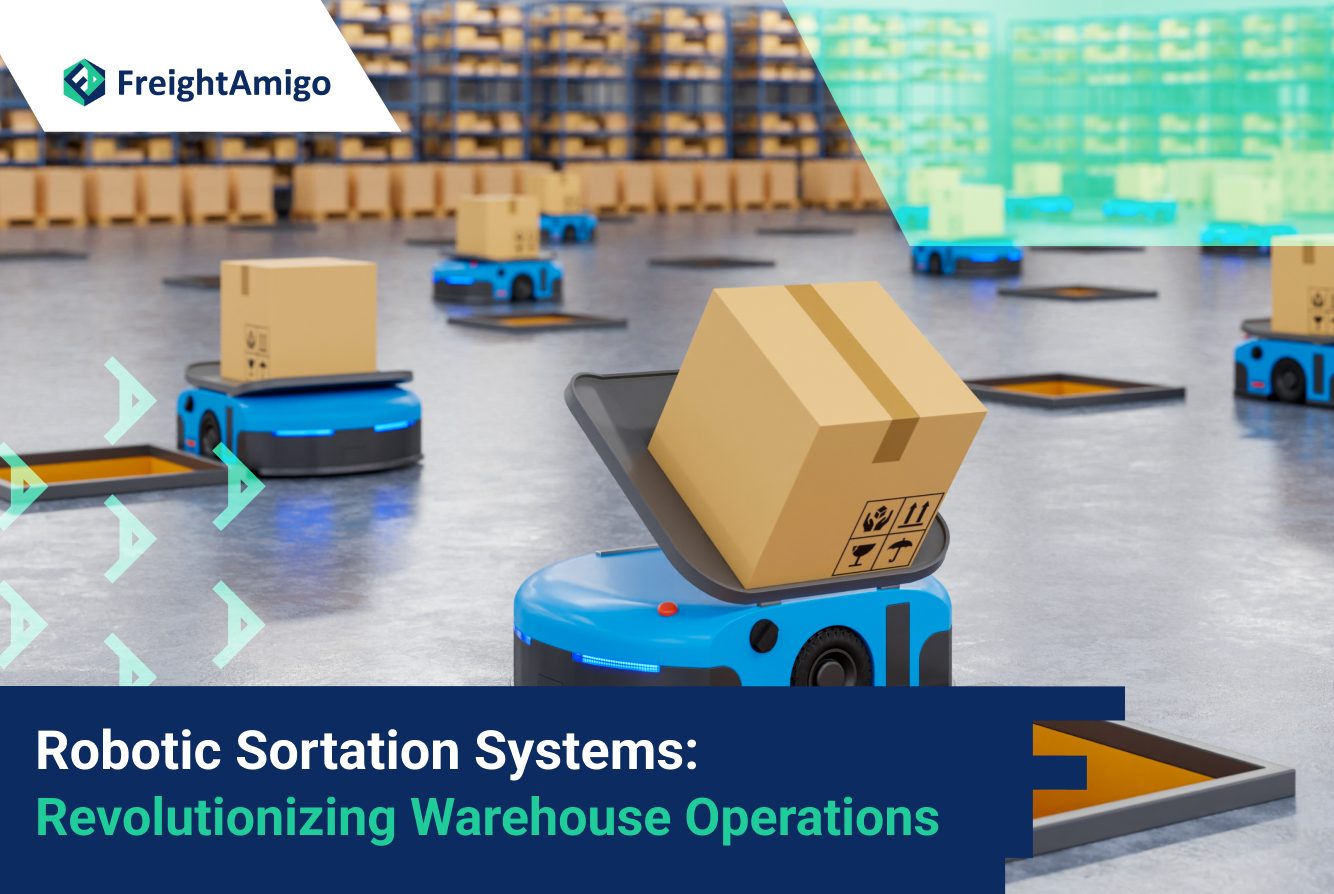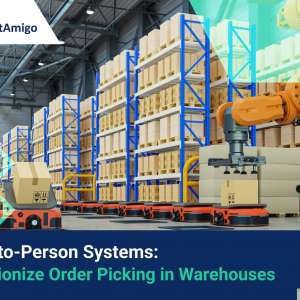In the ever-evolving landscape of warehouse operations, robotic sortation systems have emerged as a game-changer. These automated systems offer a flexible and efficient solution for sorting various items, such as packages, parcels, carts, bins, and more. In this article, we will delve into the world of robotic sortation, exploring what it entails, how it works, and the advantages it offers to warehouses and distribution centers. We will also discuss critical considerations for selecting the right system, and how FreightAmigo integrates seamlessly with these systems to optimize warehouse operations and order fulfillment processes.
Author Name:Tiffany Lee – Marketing Analyst at FreightAmigo
Want to compare the best Express, Air Freight, Sea Freight, Rail Freight & Trucking rates so as to have better control on cost?
What Are Robotic Sortation Systems?
Modern robotic sortation systems utilize advanced technologies such as robotics, conveyors, carousels, and vision-guided technology. Warehouses, distribution centers, and logistics facilities employ a variety of sortation methods based on the type of facility and its location in the process flow. The size and existing capabilities of a warehouse determine the type of the system required.
How Does a Robotic Sortation System Work?
These systems are capable of performing both primary and secondary sort processes. The primary sort processes involve receiving items and decanting them into bins or totes. On the other hand, secondary sort processes are focused on sorting items for customer orders. Multiple types of sortation methods are available, including:
- Conveyance Sortation: This method diverts cases from a centralized conveyance system to different destinations, such as gaylords, packing stations, or other process lines.
- Put Walls: Put walls consolidate multiple items into a single container or divide a bulk batch of the same SKUs into multiple containers, often used in batch picking.
- ASRS Sortation: ASRS (Automated Storage and Retrieval Systems) are high-density systems that store and sort products using various methods, such as vertical or horizontal carousels, robotic shuttles, or cuboidal hives filled with smart robots.
- Robotic Sortation: Highly flexible and scalable, robotic sortation systems utilize robotic arms to receive, scan, sort, and stow products for processing or consolidation.
- AMR/AGV: Autonomous Mobile Robots (AMR) or Automated Guided Vehicles (AGV) employ autonomous vehicles to sort pallets or pods of products for storage and retrieval. This method is suitable for heavy, single-SKU products located on pallets or SKUs sorted across multiple locations.
While AMR/AGV is often referred to as robotic sortation, its use of high conveyance and vehicles distinguishes it from robotic arm-based systems.
Advantages of Using Robotic Sortation Systems
Implementing robotic sortation systems in warehouses and ecommerce order fulfillment centers brings numerous benefits. These systems simplify large-scale and complex sorting tasks, making them more manageable and efficient. Let’s explore the advantages of utilizing robotic sortation systems:
-
Improved Order Fulfillment Accuracy and Speed
Robotic sorting significantly enhances order fulfillment accuracy and speed by reducing errors and improving overall efficiency. Sorting items in a warehouse or fulfillment center is a repetitive task, and human error can be costly. Unlike human workers, these systems can handle multiple items simultaneously, significantly reducing the effort required to pick up each item from the conveyor belt. This increased speed and accuracy result in faster order processing and fewer errors.
-
Handling a Wide Variety of Items
These systems offer the ability to manipulate a wide variety of items. With options for dynamic dimensioning, positioning, barcode reading, and scan-in-flight capabilities, these systems can effectively handle diverse products of varying shapes, sizes, and weights. This flexibility makes them suitable for warehouses dealing with a wide range of products.
-
Flexibility in Sorting Methods
These systems provide flexibility in sorting items to conveyance systems, gaylords, or pack-out areas. Whether you need to consolidate items into a single container or divide them into multiple containers, robotic sortation systems can adapt to your specific requirements. These systems seamlessly integrate with existing ASRS, conveyance, AMRs, or put walls, allowing for a smooth flow of products throughout the warehouse.
-
Lower Fixed Infrastructure Requirements
Compared to traditional sortation systems, robotic sortation requires lower fixed infrastructure. These systems can be easily scaled by duplicating robotic “work cells” when rate or throughput requirements increase. This scalability allows warehouses to adapt to changing demands without significant investment in additional infrastructure.
-
Easy Reprogramming and Repurposing
These systems can be reprogrammed or repurposed to accommodate new items or perform different sortation processes. This adaptability ensures that warehouses can quickly respond to changing inventory or order fulfillment needs without significant downtime or operational disruptions.
-
Utilization of Commercially Available and Reliable Components
These systems utilize commercially available, highly reliable components. These components are extensively tested and proven in various industries, ensuring the durability and longevity of the system. By leveraging established technologies, warehouses can trust that their robotic sortation systems will operate smoothly and efficiently.
Considerations for Introducing Robotic Sortation Systems to a Warehouse
Before implementing a robotic sortation system, warehouses and distribution centers must consider several factors to ensure its effectiveness. Let’s explore these considerations:
-
Warehouse Volume, Space, and Ergonomics
Understanding the volume, space, and ergonomics of your operation is crucial. You need to assess the available space for installing a sortation system, ensuring there is enough room for robotic arms, conveyor belts, and output bins. Additionally, consider the ergonomic requirements for human operators working alongside the robotic sortation system.
-
Product Volume and Scalability
Evaluate the volume of items, parts, or products that need to be sorted and how it may scale over time. Understanding the growth potential of your business will help determine the scalability requirements for the robotic sortation system.
-
Technology Integration
Collaborate with experienced integrators to plan an end-to-end automation solution that incorporates the necessary technologies for success. It is essential to create a collaborative system that allows seamless interaction between robots and human operators.
How FreightAmigo Enhances Robotic Sortation Systems
FreightAmigo seamlessly integrates with robotic sortation systems to optimize warehouse operations and streamline order fulfillment processes. By collaborating with these systems, FreightAmigo ensures accurate sorting and efficient handling of packages, improving overall operational efficiency.
As experts in warehouse management and automation, FreightAmigo complements these systems, maximizing their effectiveness within the warehouse environment. Their real-time order information and coordination with robotic systems streamline order processing and ensure timely delivery.
FreightAmigo’s scalable and flexible logistics solutions align perfectly with the scalability and flexibility of robotic sortation systems. They can manage diverse supply chains and adapt to market demands. By partnering with robotic sortation systems, FreightAmigo helps businesses achieve accurate sorting, faster order fulfillment, and enhanced customer satisfaction.
Conclusion
Robotic sortation systems have revolutionized warehouse operations, offering flexible, efficient, and accurate sorting solutions. These systems improve order fulfillment accuracy and speed, handle a wide variety of items, and provide flexibility in sorting methods. With lower fixed infrastructure requirements and the ability to be easily reprogrammed or repurposed, robotic sortation systems offer a scalable solution for warehouses and distribution centers.
When combined with FreightAmigo’s expertise in warehouse management and automation, organizations can optimize their operations, achieve accurate sorting, and enhance overall efficiency. By seamlessly integrating with robotic sortation systems, FreightAmigo ensures streamlined order fulfillment processes and improved customer satisfaction. Embrace the power of robotic sortation systems and experience the transformation they bring to your warehouse operations.
There are different options for cargo transportation. If you want to choose the most convenient and suitable solution, it is best to have the full support of logistics experts! If you are planning to ship goods overseas, please go to the FreightAmigo page for inquiries.
===
Read More:
【Market Entry Strategies】 A Comprehensive Guide for Successful Expansion
【Electric Trucks】Revolutionizing Sustainable Logistics
【Route Optimization in Logistics】Enhancing Efficiency and Cost Savings
===
If you have any inquiries on logistics/supply chain, feel free to contact FreightAmigo now:
Chat with us online OR
Phone : +852 28121686
WhatsApp: +852 27467829









































